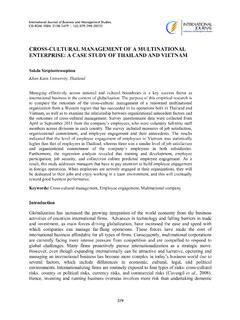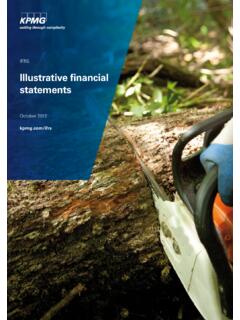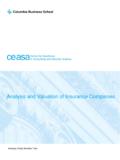Transcription of PROFIT AND LOSS ACCOUNT OR COMPREHENSIVE …
1 International Journal of Business and Management Studies,CD-ROM. ISSN: 2158-1479 :: 1(3):179 188 (2012) PROFIT AND loss ACCOUNT OR COMPREHENSIVE income STATEMENT: which IS THE BEST? Ionel Jianu and Iulia Jianu Bucharest Academy of Economic Studies, Romania Ionela Gusatu Bucharest University of Medicine and Pharmacy !Carol Davila", Romania The net income was considered for a long period of time the main indicator for measuring the financial performance of the economic entity. It is said that when entity obtains PROFIT then the entity does performance. The net income is oriented towards the past, by its method of calculation, serving as a measure of the progress of the entity during a period of time in the past. Currently, the net income lost and still tends to lose "land" in the process of measuring financial performance due to the emergence of a new concept: the COMPREHENSIVE income . This study aims to identify which one of the two financial statements, which one discloses the performance of the economic entity: the PROFIT and loss ACCOUNT or the COMPREHENSIVE income statement preferred by investors.
2 Based on data collected from the financial statements of the 62 companies listed on the London Stock Exchange, this study shows that PROFIT and loss ACCOUNT is the financial statement preferred by investors in assessing the financial performance of the economic entity. Keywords: COMPREHENSIVE income , IFRS, Net income , Performance 1. Introduction For a long time, the accounting result was considered to be the main indicator for measuring the performance of the economic entity. It is said that when the entity obtains PROFIT , it does performance. In the approach regarding the concept of PROFIT , we will focus on some opinions expressed by authors that are known internationally. Adam Smith, quoted by Babeau (1985), defines PROFIT as the total economic income of the entity after deducting wages and ground rents. Joseph Scumpeter defines PROFIT as a surplus of income over cost. In the history of relative theories regarding PROFIT , a special place must have Marx, who shows that the PROFIT on selling a good is part of the value of that good.
3 Heyne P. (1991) considers the PROFIT as the difference between total revenues and total expenditures. In the author!s opinion, total expenditure should include the so-called suppletive costs such as the owner!s wage, the rent of the used building that is owned by the shareholder. The accounting result has seen some developments over time. In the Stalinist period, in a Soviet-type economy, the accounting result was represented by the difference between sales, on the one hand and consumption and compensation of staff, on the other hand. Interest rates and taxes were not considered as expenses, but as result distributions. This concept of result was very logical given that most of the entities were the property of the state. In an economy of the 179180 Ionel Jianu, Iulia Jianu and Ionela GusatuYugoslav self-management type, in Tito s time, the entity's accounting result was represented by the difference between sales on the one hand, and the amount of costs, interest rates and taxes, on the other hand.
4 The remuneration of the staff was not considered as expense because in a self-management type economy, where the owners of the entity were associated producers, it was not required to include the costs of their remuneration (Richard, 1996). Taking into ACCOUNT the method of its calculation the accounting result is oriented towards the past, serving as a measure of the progress recorded by an entity during a period of time in the past. However, the accounting result may have other uses: a guide for the policy of dividends and for acquiring entity, a means of predicting future results in order to take investment or disinvestment decisions; a means of assessing the capacity of the management to run the entity; a means to assess the value of decisions taken by other groups related to the entity; a management tool in a number of areas inside or outside the entity as pricing policy, wage negotiations, credibility in front of credit agencies, price regulation under monopoly (Olimid, 1998).
5 The accounting result is the difference between total revenues and total expenses. The calculation of the accounting result is disclosed in the PROFIT and loss ACCOUNT . The PROFIT and loss ACCOUNT includes only the consequences of operational, normal activities for the period, and it reports on equity the activities that are not related to the operation. By the simple difference between revenues and expenses, the result is a partially elected date. Being oriented towards the past, the accounting result takes into ACCOUNT only the revenues and expenses, without allowing a forecast of future gains and losses. This disadvantage of the accounting result has led to another concept in accounting for measuring the performance of the entity: the COMPREHENSIVE income . The COMPREHENSIVE income is the relevant indicator that informs the entity's performance, because it takes into ACCOUNT not only past and present results but also the possibility of obtaining a favorable result in the future.
6 The COMPREHENSIVE income is calculated as follows: The COMPREHENSIVE income = Net income + Gains and losses directly recorded in equity The calculation of the result of the year is disclosed in the PROFIT and loss ACCOUNT and the calculation of COMPREHENSIVE income is disclosed in the COMPREHENSIVE income statement. 2. The PROFIT and loss ACCOUNT or the COMPREHENSIVE income statement? A company obtains PROFIT by carrying out two types of activities: those that combine or transform production factors into goods whose sale value is greater than the value of inputs and activities necessary to obtain some gains due to the increased value of production factors that are in the possession of the entity. The decisions arising from these two activities are so different that their separation is inevitable for assessing the fairness of management decisions. There must be a clear distinction between the change of the value resulting from production and the change of the value resulting from the passage of time (Edwards & Bell, 1961).
7 The acquisition of any asset is considered a satisfactory investment as long as the present value of future cash flows generated by its use is higher than the present value of future revenues generated by the alternative use of the amount that would currently be obtained from the sale of the asset. No matter how fixed would be the intention to use an asset over a long period of time, it is wise that when a higher profitability opportunity is found, the asset should be sold and they should invest in another one. Thus, goods are purchased not only to take advantage of the margins from sales, but also to benefit from the expected changes in prices, be they general or relative. Only the COMPREHENSIVE income can be used to assess the performance of the entity and its managers (Chambers, 1994). To reflect this, we propose the following example: Suppose there are two companies with an initial capital of 4,000 mu.
8 The accounting value of a land held by PROFIT and loss ACCOUNT or COMPREHENSIVE income Statement which is the Best?181each of the two entities is 1,000 um at the end of year N, while its market value is 5,000 mu. During the year N, the companies recorded only expenses with the staff amounting to 3,000 um. The first entity makes the asset revaluation and the second entity sells the asset at its market value of 5,000 mu. In this case, we do not take into ACCOUNT the impact generated by the tax for PROFIT . The gain from the revaluation of assets is not recorded in the PROFIT and loss ACCOUNT but it directly affects the entity's equity . The situation in the income statement is as follows: Company I Company II Revenues from the disposal of assets 0 5,000 Expenses on disposed assets 0 (1,000) Staff costs (3,000) (3,000) Net income (3,000) 1,000 This happened because, for the first company, unrealized profits from the revaluation of assets have been recorded in equity without transiting the PROFIT or loss ACCOUNT .
9 Company I Company II Initial equity 4,000 4,000 Revaluation reserves 4,000 0 Net income (3,000) 1,000 Final equity 5,000 5,000 If we were to calculate the variation of equity, we would obtain the same result, namely 1,000 mu. This variation reflects how the company enriched and reflects the indicator known as the COMPREHENSIVE income . The COMPREHENSIVE income statement is as follows: Company I Company II Gain from the sale of assets 0 4,000 Staff costs (3,000) (3,000) Gain from the revaluation of assets 4,000 0 The COMPREHENSIVE income 1,000 1,000 Then arises the question: which one of the two entities is more powerful? Looking through the result of the PROFIT and loss ACCOUNT , we would say that the latter is more powerful because it obtained PROFIT . But it is not true because both entities enriched with the same amount, the former by increasing the land value and the latter by the gain obtained from the sale of the land. So both entities are equally powerful and the COMPREHENSIVE income statement reflects this reality.
10 That is why the COMPREHENSIVE income tends to be the key indicator in assessing the performance of an economic entity. 3. A brief history on the rise of the COMPREHENSIVE income The term COMPREHENSIVE income first appeared in 1980 in the American legal texts (SFAC 3). It took four years (SFAC 5) 1984 to clarify its content and its difference with the one of net income : "the COMPREHENSIVE income is an extensive measure of the effects of transactions and of other events of an entity, that is, all changes in equity except for those resulting from 182 Ionel Jianu, Iulia Jianu and Ionela Gusatucontributions and distributions to owners" (Delaney P., 2003). If the definition of the concept required 4 years, its implementation required 13 years. SFAS 130/1997 establishes its application for the annual periods beginning after December 15, 1997. In terms of substance, the COMPREHENSIVE income is presented as the sum between the net income (calculated and disclosed in the PROFIT and loss ACCOUNT ) and other gains and losses (provided as the totality of items charged against equity).










